NMDF211 Report: Nutritional Biochemistry of Iron and Vitamin D Status
VerifiedAdded on 2022/11/09
|8
|1834
|59
Report
AI Summary
This report delves into the nutritional and biochemical aspects of iron and vitamin D, focusing on their absorption, metabolism, and impact on health, particularly in the case of a 50-year-old female named Liz. Liz presents with symptoms indicative of both vitamin D and iron deficiencies, including fatigue, muscle pain, and other related physical manifestations. The report examines the underlying metabolic processes, such as the hydroxylation of vitamin D and iron absorption pathways, highlighting the roles of magnesium and vitamin C in these processes. It further discusses the implications of these deficiencies, including risks of cardiovascular disease, bone loss, and anemia. The report emphasizes the importance of dietary interventions, such as increasing the intake of foods rich in vitamin D, iron, calcium, magnesium, and vitamin C, considering Liz's vegetarian dietary habits. The paper concludes by underscoring the positive health outcomes associated with targeted dietary strategies to improve iron and vitamin D status, supported by a comprehensive list of references.
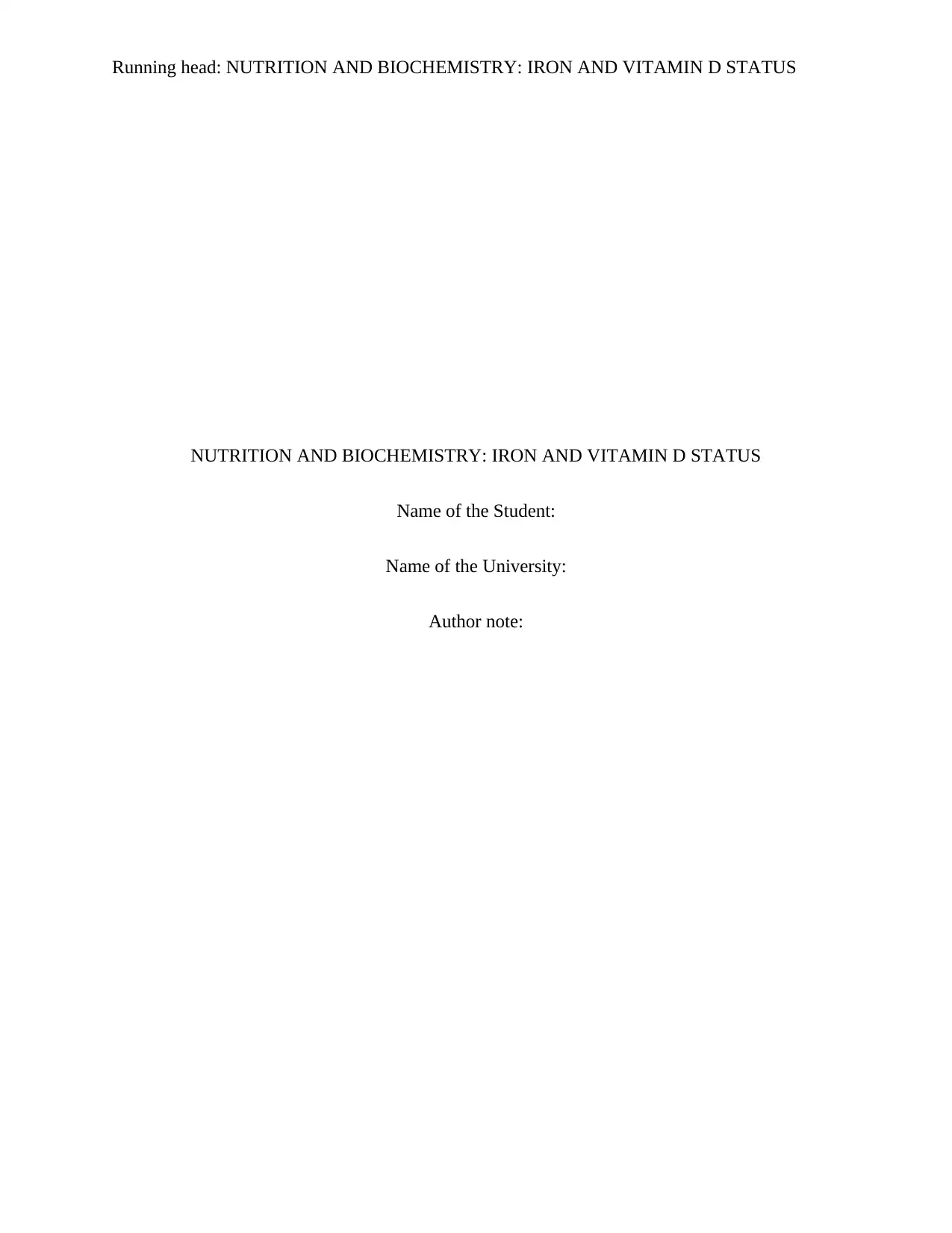
Running head: NUTRITION AND BIOCHEMISTRY: IRON AND VITAMIN D STATUS
NUTRITION AND BIOCHEMISTRY: IRON AND VITAMIN D STATUS
Name of the Student:
Name of the University:
Author note:
NUTRITION AND BIOCHEMISTRY: IRON AND VITAMIN D STATUS
Name of the Student:
Name of the University:
Author note:
Paraphrase This Document
Need a fresh take? Get an instant paraphrase of this document with our AI Paraphraser
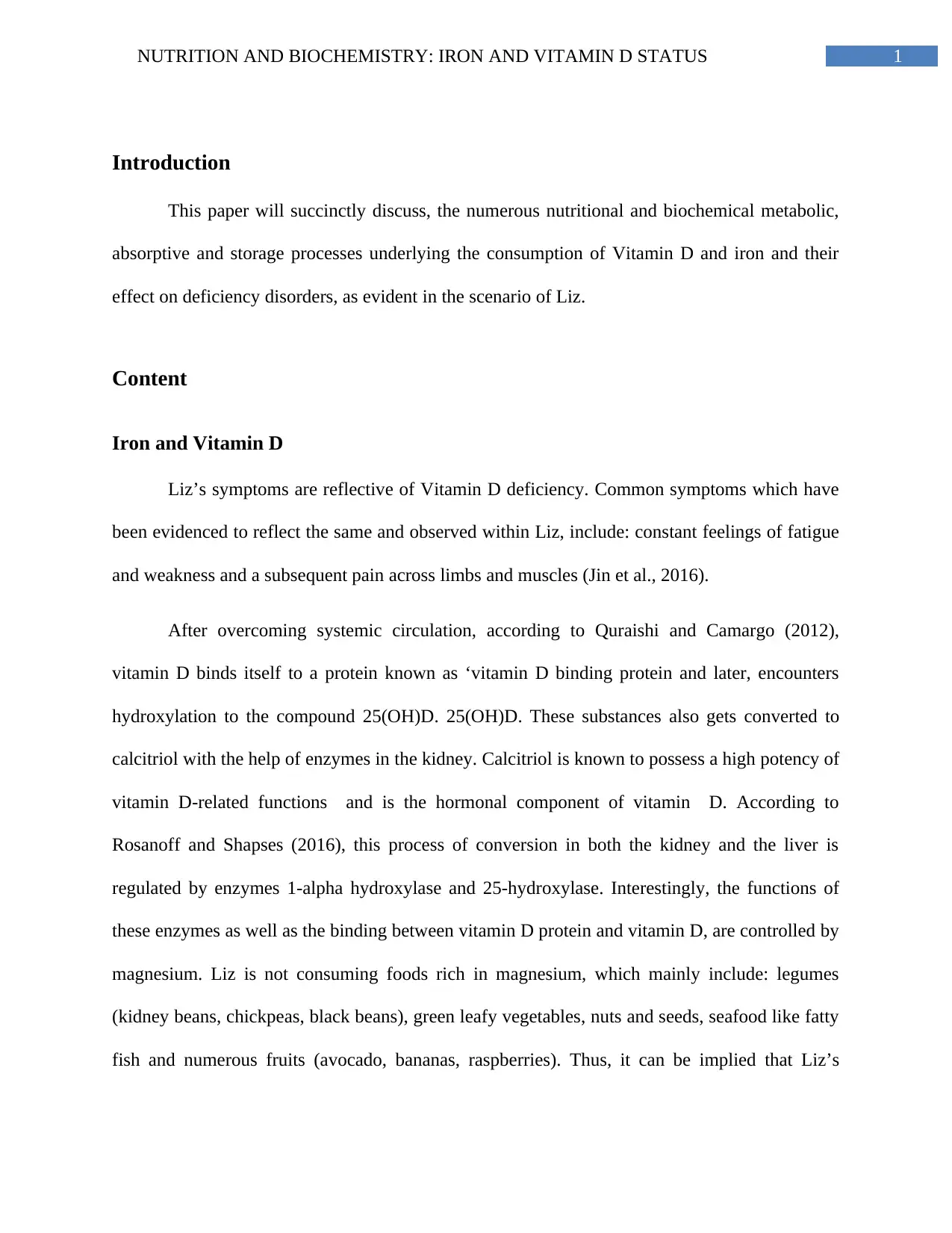
1NUTRITION AND BIOCHEMISTRY: IRON AND VITAMIN D STATUS
Introduction
This paper will succinctly discuss, the numerous nutritional and biochemical metabolic,
absorptive and storage processes underlying the consumption of Vitamin D and iron and their
effect on deficiency disorders, as evident in the scenario of Liz.
Content
Iron and Vitamin D
Liz’s symptoms are reflective of Vitamin D deficiency. Common symptoms which have
been evidenced to reflect the same and observed within Liz, include: constant feelings of fatigue
and weakness and a subsequent pain across limbs and muscles (Jin et al., 2016).
After overcoming systemic circulation, according to Quraishi and Camargo (2012),
vitamin D binds itself to a protein known as ‘vitamin D binding protein and later, encounters
hydroxylation to the compound 25(OH)D. 25(OH)D. These substances also gets converted to
calcitriol with the help of enzymes in the kidney. Calcitriol is known to possess a high potency of
vitamin D-related functions and is the hormonal component of vitamin D. According to
Rosanoff and Shapses (2016), this process of conversion in both the kidney and the liver is
regulated by enzymes 1-alpha hydroxylase and 25-hydroxylase. Interestingly, the functions of
these enzymes as well as the binding between vitamin D protein and vitamin D, are controlled by
magnesium. Liz is not consuming foods rich in magnesium, which mainly include: legumes
(kidney beans, chickpeas, black beans), green leafy vegetables, nuts and seeds, seafood like fatty
fish and numerous fruits (avocado, bananas, raspberries). Thus, it can be implied that Liz’s
Introduction
This paper will succinctly discuss, the numerous nutritional and biochemical metabolic,
absorptive and storage processes underlying the consumption of Vitamin D and iron and their
effect on deficiency disorders, as evident in the scenario of Liz.
Content
Iron and Vitamin D
Liz’s symptoms are reflective of Vitamin D deficiency. Common symptoms which have
been evidenced to reflect the same and observed within Liz, include: constant feelings of fatigue
and weakness and a subsequent pain across limbs and muscles (Jin et al., 2016).
After overcoming systemic circulation, according to Quraishi and Camargo (2012),
vitamin D binds itself to a protein known as ‘vitamin D binding protein and later, encounters
hydroxylation to the compound 25(OH)D. 25(OH)D. These substances also gets converted to
calcitriol with the help of enzymes in the kidney. Calcitriol is known to possess a high potency of
vitamin D-related functions and is the hormonal component of vitamin D. According to
Rosanoff and Shapses (2016), this process of conversion in both the kidney and the liver is
regulated by enzymes 1-alpha hydroxylase and 25-hydroxylase. Interestingly, the functions of
these enzymes as well as the binding between vitamin D protein and vitamin D, are controlled by
magnesium. Liz is not consuming foods rich in magnesium, which mainly include: legumes
(kidney beans, chickpeas, black beans), green leafy vegetables, nuts and seeds, seafood like fatty
fish and numerous fruits (avocado, bananas, raspberries). Thus, it can be implied that Liz’s
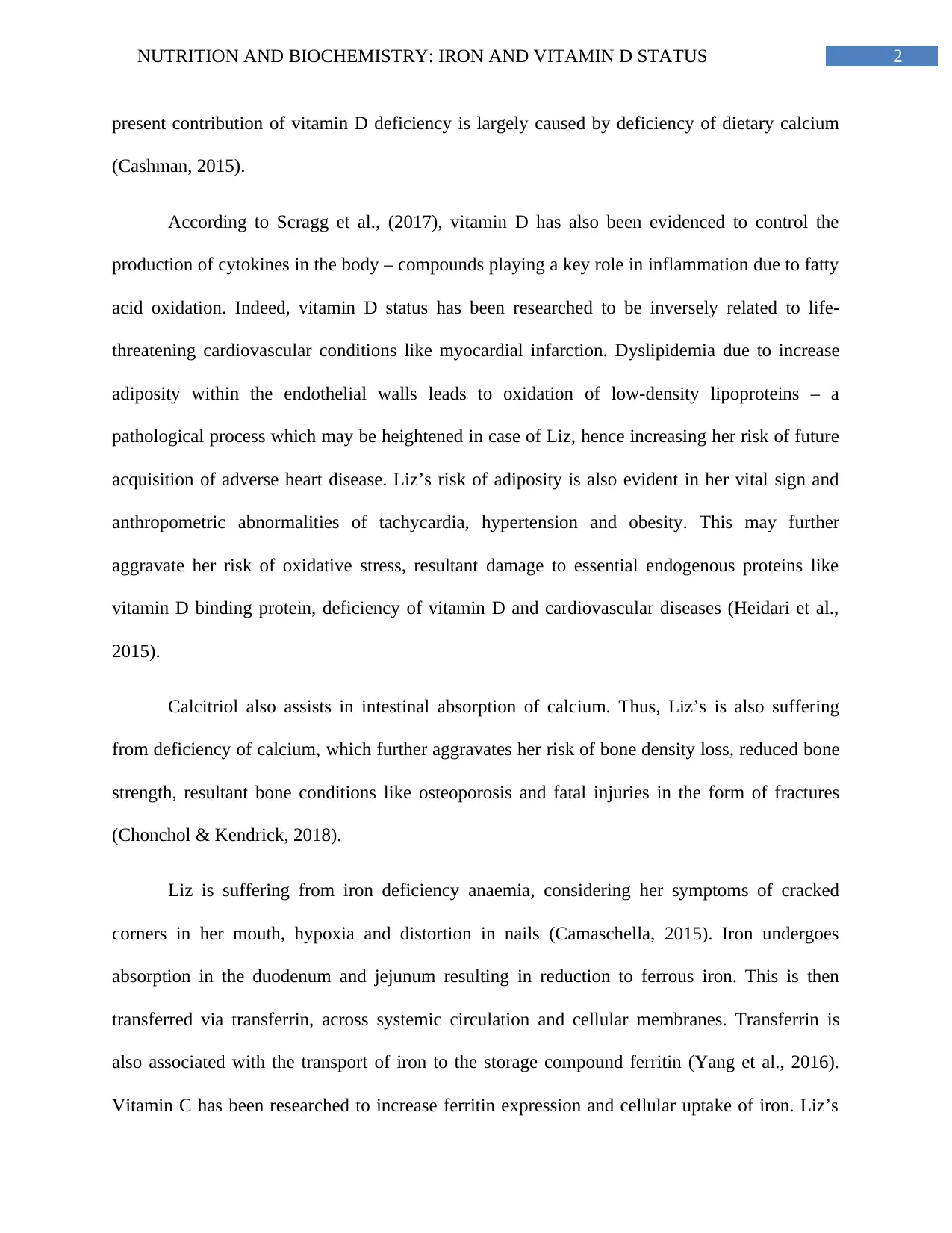
2NUTRITION AND BIOCHEMISTRY: IRON AND VITAMIN D STATUS
present contribution of vitamin D deficiency is largely caused by deficiency of dietary calcium
(Cashman, 2015).
According to Scragg et al., (2017), vitamin D has also been evidenced to control the
production of cytokines in the body – compounds playing a key role in inflammation due to fatty
acid oxidation. Indeed, vitamin D status has been researched to be inversely related to life-
threatening cardiovascular conditions like myocardial infarction. Dyslipidemia due to increase
adiposity within the endothelial walls leads to oxidation of low-density lipoproteins – a
pathological process which may be heightened in case of Liz, hence increasing her risk of future
acquisition of adverse heart disease. Liz’s risk of adiposity is also evident in her vital sign and
anthropometric abnormalities of tachycardia, hypertension and obesity. This may further
aggravate her risk of oxidative stress, resultant damage to essential endogenous proteins like
vitamin D binding protein, deficiency of vitamin D and cardiovascular diseases (Heidari et al.,
2015).
Calcitriol also assists in intestinal absorption of calcium. Thus, Liz’s is also suffering
from deficiency of calcium, which further aggravates her risk of bone density loss, reduced bone
strength, resultant bone conditions like osteoporosis and fatal injuries in the form of fractures
(Chonchol & Kendrick, 2018).
Liz is suffering from iron deficiency anaemia, considering her symptoms of cracked
corners in her mouth, hypoxia and distortion in nails (Camaschella, 2015). Iron undergoes
absorption in the duodenum and jejunum resulting in reduction to ferrous iron. This is then
transferred via transferrin, across systemic circulation and cellular membranes. Transferrin is
also associated with the transport of iron to the storage compound ferritin (Yang et al., 2016).
Vitamin C has been researched to increase ferritin expression and cellular uptake of iron. Liz’s
present contribution of vitamin D deficiency is largely caused by deficiency of dietary calcium
(Cashman, 2015).
According to Scragg et al., (2017), vitamin D has also been evidenced to control the
production of cytokines in the body – compounds playing a key role in inflammation due to fatty
acid oxidation. Indeed, vitamin D status has been researched to be inversely related to life-
threatening cardiovascular conditions like myocardial infarction. Dyslipidemia due to increase
adiposity within the endothelial walls leads to oxidation of low-density lipoproteins – a
pathological process which may be heightened in case of Liz, hence increasing her risk of future
acquisition of adverse heart disease. Liz’s risk of adiposity is also evident in her vital sign and
anthropometric abnormalities of tachycardia, hypertension and obesity. This may further
aggravate her risk of oxidative stress, resultant damage to essential endogenous proteins like
vitamin D binding protein, deficiency of vitamin D and cardiovascular diseases (Heidari et al.,
2015).
Calcitriol also assists in intestinal absorption of calcium. Thus, Liz’s is also suffering
from deficiency of calcium, which further aggravates her risk of bone density loss, reduced bone
strength, resultant bone conditions like osteoporosis and fatal injuries in the form of fractures
(Chonchol & Kendrick, 2018).
Liz is suffering from iron deficiency anaemia, considering her symptoms of cracked
corners in her mouth, hypoxia and distortion in nails (Camaschella, 2015). Iron undergoes
absorption in the duodenum and jejunum resulting in reduction to ferrous iron. This is then
transferred via transferrin, across systemic circulation and cellular membranes. Transferrin is
also associated with the transport of iron to the storage compound ferritin (Yang et al., 2016).
Vitamin C has been researched to increase ferritin expression and cellular uptake of iron. Liz’s
⊘ This is a preview!⊘
Do you want full access?
Subscribe today to unlock all pages.

Trusted by 1+ million students worldwide
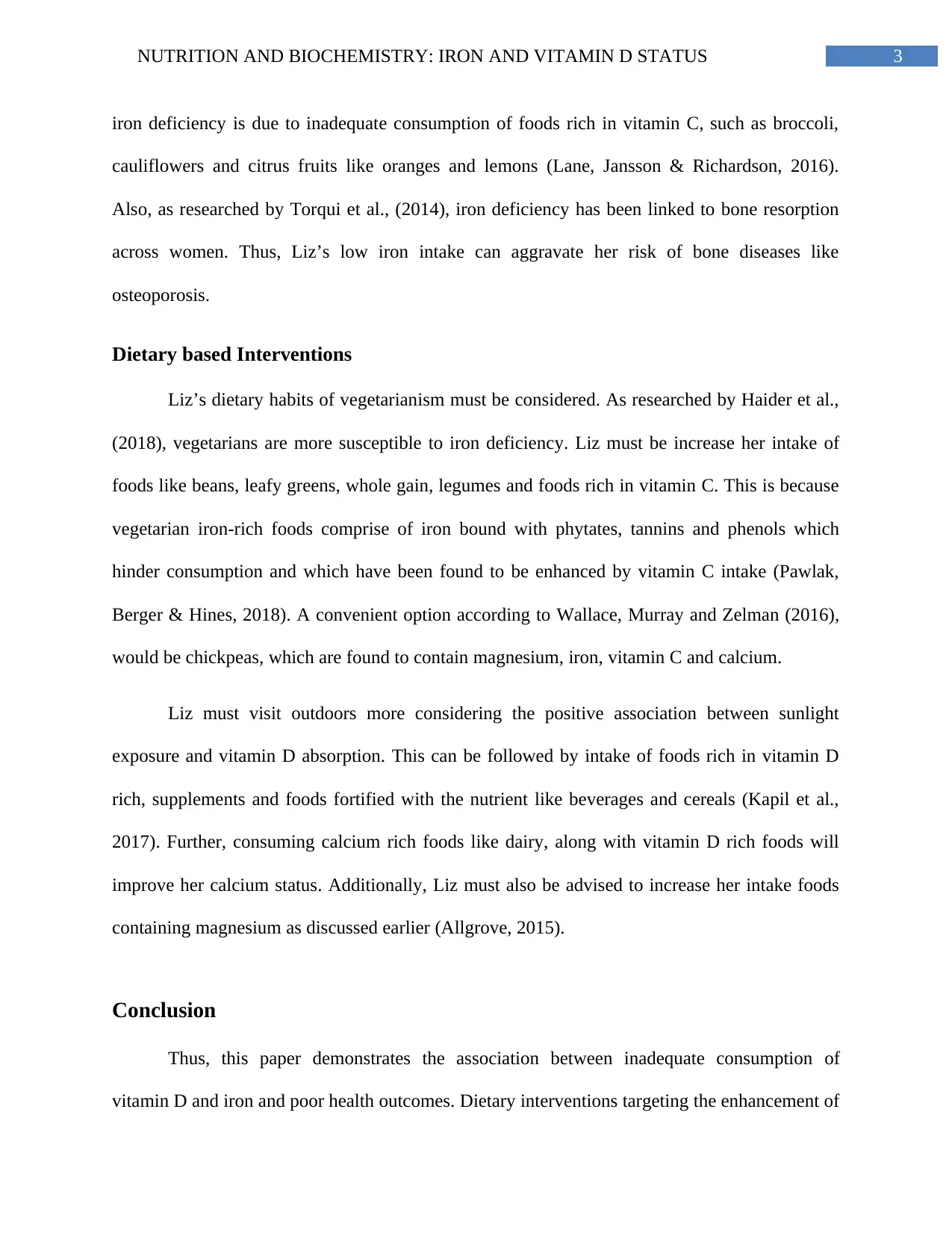
3NUTRITION AND BIOCHEMISTRY: IRON AND VITAMIN D STATUS
iron deficiency is due to inadequate consumption of foods rich in vitamin C, such as broccoli,
cauliflowers and citrus fruits like oranges and lemons (Lane, Jansson & Richardson, 2016).
Also, as researched by Torqui et al., (2014), iron deficiency has been linked to bone resorption
across women. Thus, Liz’s low iron intake can aggravate her risk of bone diseases like
osteoporosis.
Dietary based Interventions
Liz’s dietary habits of vegetarianism must be considered. As researched by Haider et al.,
(2018), vegetarians are more susceptible to iron deficiency. Liz must be increase her intake of
foods like beans, leafy greens, whole gain, legumes and foods rich in vitamin C. This is because
vegetarian iron-rich foods comprise of iron bound with phytates, tannins and phenols which
hinder consumption and which have been found to be enhanced by vitamin C intake (Pawlak,
Berger & Hines, 2018). A convenient option according to Wallace, Murray and Zelman (2016),
would be chickpeas, which are found to contain magnesium, iron, vitamin C and calcium.
Liz must visit outdoors more considering the positive association between sunlight
exposure and vitamin D absorption. This can be followed by intake of foods rich in vitamin D
rich, supplements and foods fortified with the nutrient like beverages and cereals (Kapil et al.,
2017). Further, consuming calcium rich foods like dairy, along with vitamin D rich foods will
improve her calcium status. Additionally, Liz must also be advised to increase her intake foods
containing magnesium as discussed earlier (Allgrove, 2015).
Conclusion
Thus, this paper demonstrates the association between inadequate consumption of
vitamin D and iron and poor health outcomes. Dietary interventions targeting the enhancement of
iron deficiency is due to inadequate consumption of foods rich in vitamin C, such as broccoli,
cauliflowers and citrus fruits like oranges and lemons (Lane, Jansson & Richardson, 2016).
Also, as researched by Torqui et al., (2014), iron deficiency has been linked to bone resorption
across women. Thus, Liz’s low iron intake can aggravate her risk of bone diseases like
osteoporosis.
Dietary based Interventions
Liz’s dietary habits of vegetarianism must be considered. As researched by Haider et al.,
(2018), vegetarians are more susceptible to iron deficiency. Liz must be increase her intake of
foods like beans, leafy greens, whole gain, legumes and foods rich in vitamin C. This is because
vegetarian iron-rich foods comprise of iron bound with phytates, tannins and phenols which
hinder consumption and which have been found to be enhanced by vitamin C intake (Pawlak,
Berger & Hines, 2018). A convenient option according to Wallace, Murray and Zelman (2016),
would be chickpeas, which are found to contain magnesium, iron, vitamin C and calcium.
Liz must visit outdoors more considering the positive association between sunlight
exposure and vitamin D absorption. This can be followed by intake of foods rich in vitamin D
rich, supplements and foods fortified with the nutrient like beverages and cereals (Kapil et al.,
2017). Further, consuming calcium rich foods like dairy, along with vitamin D rich foods will
improve her calcium status. Additionally, Liz must also be advised to increase her intake foods
containing magnesium as discussed earlier (Allgrove, 2015).
Conclusion
Thus, this paper demonstrates the association between inadequate consumption of
vitamin D and iron and poor health outcomes. Dietary interventions targeting the enhancement of
Paraphrase This Document
Need a fresh take? Get an instant paraphrase of this document with our AI Paraphraser
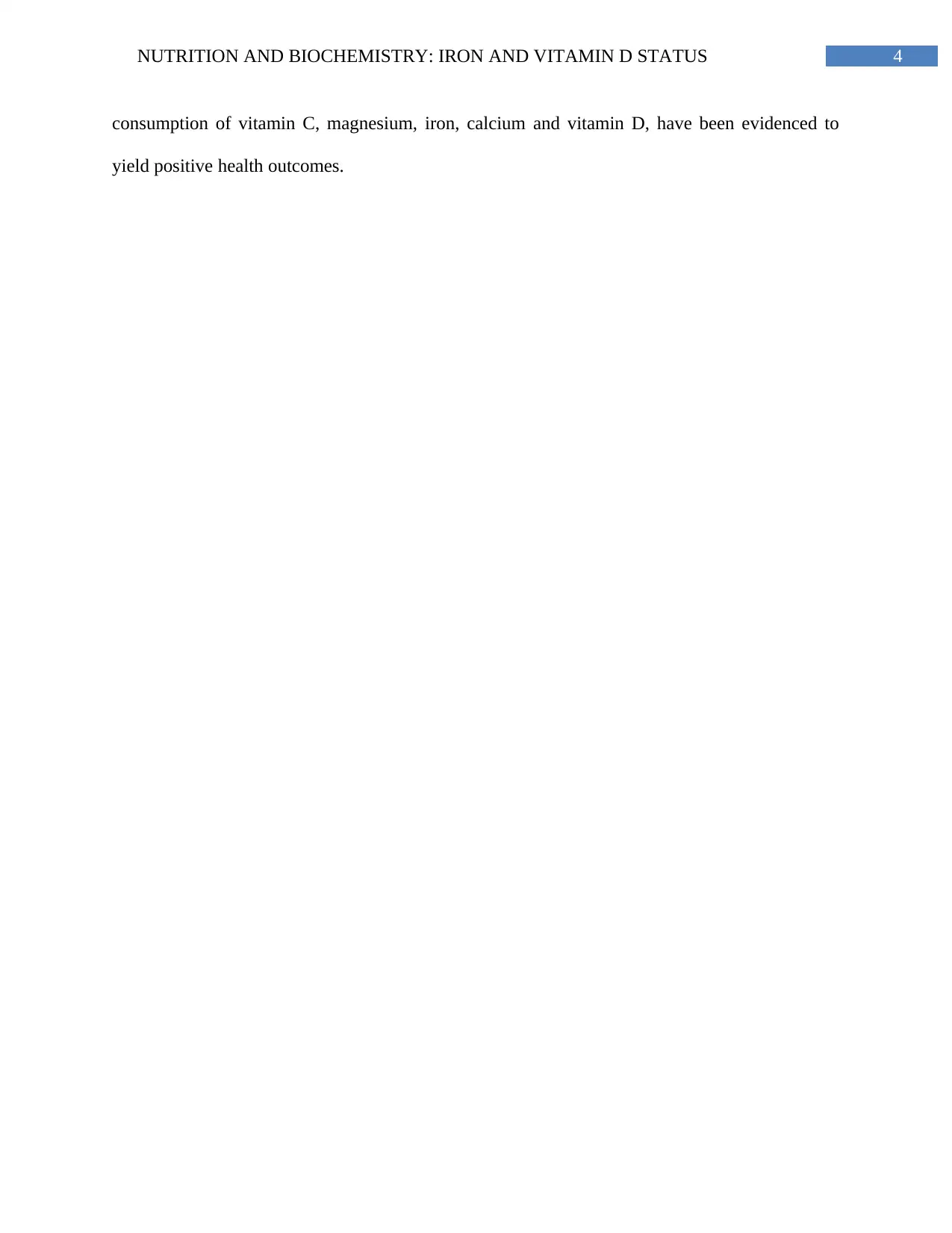
4NUTRITION AND BIOCHEMISTRY: IRON AND VITAMIN D STATUS
consumption of vitamin C, magnesium, iron, calcium and vitamin D, have been evidenced to
yield positive health outcomes.
consumption of vitamin C, magnesium, iron, calcium and vitamin D, have been evidenced to
yield positive health outcomes.
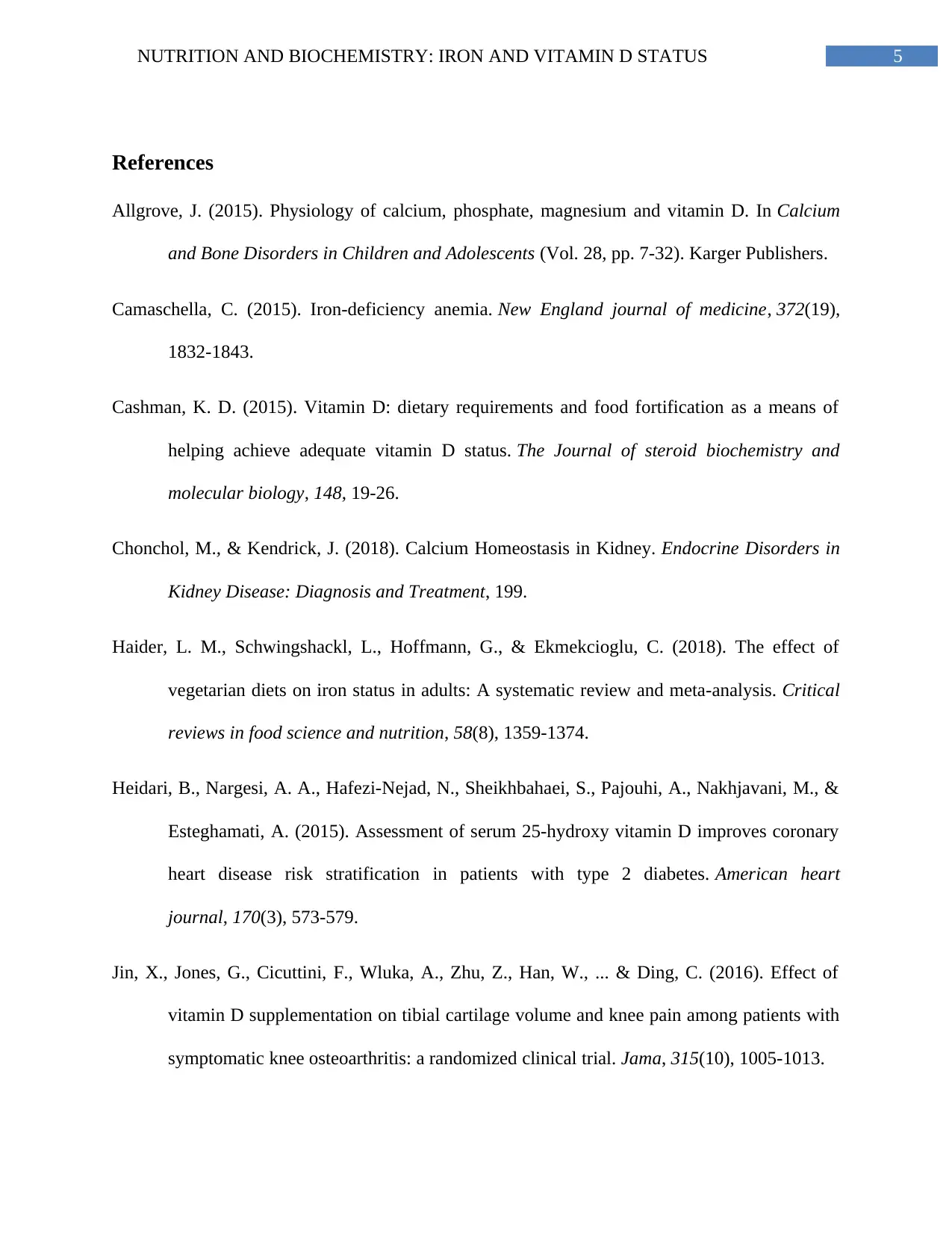
5NUTRITION AND BIOCHEMISTRY: IRON AND VITAMIN D STATUS
References
Allgrove, J. (2015). Physiology of calcium, phosphate, magnesium and vitamin D. In Calcium
and Bone Disorders in Children and Adolescents (Vol. 28, pp. 7-32). Karger Publishers.
Camaschella, C. (2015). Iron-deficiency anemia. New England journal of medicine, 372(19),
1832-1843.
Cashman, K. D. (2015). Vitamin D: dietary requirements and food fortification as a means of
helping achieve adequate vitamin D status. The Journal of steroid biochemistry and
molecular biology, 148, 19-26.
Chonchol, M., & Kendrick, J. (2018). Calcium Homeostasis in Kidney. Endocrine Disorders in
Kidney Disease: Diagnosis and Treatment, 199.
Haider, L. M., Schwingshackl, L., Hoffmann, G., & Ekmekcioglu, C. (2018). The effect of
vegetarian diets on iron status in adults: A systematic review and meta-analysis. Critical
reviews in food science and nutrition, 58(8), 1359-1374.
Heidari, B., Nargesi, A. A., Hafezi-Nejad, N., Sheikhbahaei, S., Pajouhi, A., Nakhjavani, M., &
Esteghamati, A. (2015). Assessment of serum 25-hydroxy vitamin D improves coronary
heart disease risk stratification in patients with type 2 diabetes. American heart
journal, 170(3), 573-579.
Jin, X., Jones, G., Cicuttini, F., Wluka, A., Zhu, Z., Han, W., ... & Ding, C. (2016). Effect of
vitamin D supplementation on tibial cartilage volume and knee pain among patients with
symptomatic knee osteoarthritis: a randomized clinical trial. Jama, 315(10), 1005-1013.
References
Allgrove, J. (2015). Physiology of calcium, phosphate, magnesium and vitamin D. In Calcium
and Bone Disorders in Children and Adolescents (Vol. 28, pp. 7-32). Karger Publishers.
Camaschella, C. (2015). Iron-deficiency anemia. New England journal of medicine, 372(19),
1832-1843.
Cashman, K. D. (2015). Vitamin D: dietary requirements and food fortification as a means of
helping achieve adequate vitamin D status. The Journal of steroid biochemistry and
molecular biology, 148, 19-26.
Chonchol, M., & Kendrick, J. (2018). Calcium Homeostasis in Kidney. Endocrine Disorders in
Kidney Disease: Diagnosis and Treatment, 199.
Haider, L. M., Schwingshackl, L., Hoffmann, G., & Ekmekcioglu, C. (2018). The effect of
vegetarian diets on iron status in adults: A systematic review and meta-analysis. Critical
reviews in food science and nutrition, 58(8), 1359-1374.
Heidari, B., Nargesi, A. A., Hafezi-Nejad, N., Sheikhbahaei, S., Pajouhi, A., Nakhjavani, M., &
Esteghamati, A. (2015). Assessment of serum 25-hydroxy vitamin D improves coronary
heart disease risk stratification in patients with type 2 diabetes. American heart
journal, 170(3), 573-579.
Jin, X., Jones, G., Cicuttini, F., Wluka, A., Zhu, Z., Han, W., ... & Ding, C. (2016). Effect of
vitamin D supplementation on tibial cartilage volume and knee pain among patients with
symptomatic knee osteoarthritis: a randomized clinical trial. Jama, 315(10), 1005-1013.
⊘ This is a preview!⊘
Do you want full access?
Subscribe today to unlock all pages.

Trusted by 1+ million students worldwide

6NUTRITION AND BIOCHEMISTRY: IRON AND VITAMIN D STATUS
Kapil, U., Pandey, R. M., Goswami, R., Sharma, B., Sharma, N., Ramakrishnan, L., ... & Sofi, N.
Y. (2017). Prevalence of Vitamin D deficiency and associated risk factors among
children residing at high altitude in Shimla district, Himachal Pradesh, India. Indian
journal of endocrinology and metabolism, 21(1), 178.
Lane, D. J., Jansson, P. J., & Richardson, D. R. (2016). Bonnie and Clyde: Vitamin C and iron
are partners in crime in iron deficiency anaemia and its potential role in the elderly. Aging
(Albany NY), 8(5), 1150.
Pawlak, R., Berger, J., & Hines, I. (2018). Iron Status of Vegetarian Adults: A Review of
Literature. American journal of lifestyle medicine, 12(6), 486-498.
Quraishi, S. A., & Camargo Jr, C. A. (2012). Vitamin D in acute stress and critical
illness. Current opinion in clinical nutrition and metabolic care, 15(6), 625.
Rosanoff, A., Dai, Q., & Shapses, S. A. (2016). Essential nutrient interactions: does low or
suboptimal magnesium status interact with vitamin D and/or calcium status?. Advances in
nutrition, 7(1), 25-43.
Scragg, R., Stewart, A. W., Waayer, D., Lawes, C. M., Toop, L., Sluyter, J., ... & Camargo, C. A.
(2017). Effect of monthly high-dose vitamin D supplementation on cardiovascular
disease in the vitamin D assessment study: a randomized clinical trial. JAMA
cardiology, 2(6), 608-616.
Toxqui, L., Pérez-Granados, A. M., Blanco-Rojo, R., Wright, I., de la Piedra, C., & Vaquero, M.
P. (2014). Low iron status as a factor of increased bone resorption and effects of an iron
and vitamin D-fortified skimmed milk on bone remodelling in young Spanish
women. European journal of nutrition, 53(2), 441-448.
Kapil, U., Pandey, R. M., Goswami, R., Sharma, B., Sharma, N., Ramakrishnan, L., ... & Sofi, N.
Y. (2017). Prevalence of Vitamin D deficiency and associated risk factors among
children residing at high altitude in Shimla district, Himachal Pradesh, India. Indian
journal of endocrinology and metabolism, 21(1), 178.
Lane, D. J., Jansson, P. J., & Richardson, D. R. (2016). Bonnie and Clyde: Vitamin C and iron
are partners in crime in iron deficiency anaemia and its potential role in the elderly. Aging
(Albany NY), 8(5), 1150.
Pawlak, R., Berger, J., & Hines, I. (2018). Iron Status of Vegetarian Adults: A Review of
Literature. American journal of lifestyle medicine, 12(6), 486-498.
Quraishi, S. A., & Camargo Jr, C. A. (2012). Vitamin D in acute stress and critical
illness. Current opinion in clinical nutrition and metabolic care, 15(6), 625.
Rosanoff, A., Dai, Q., & Shapses, S. A. (2016). Essential nutrient interactions: does low or
suboptimal magnesium status interact with vitamin D and/or calcium status?. Advances in
nutrition, 7(1), 25-43.
Scragg, R., Stewart, A. W., Waayer, D., Lawes, C. M., Toop, L., Sluyter, J., ... & Camargo, C. A.
(2017). Effect of monthly high-dose vitamin D supplementation on cardiovascular
disease in the vitamin D assessment study: a randomized clinical trial. JAMA
cardiology, 2(6), 608-616.
Toxqui, L., Pérez-Granados, A. M., Blanco-Rojo, R., Wright, I., de la Piedra, C., & Vaquero, M.
P. (2014). Low iron status as a factor of increased bone resorption and effects of an iron
and vitamin D-fortified skimmed milk on bone remodelling in young Spanish
women. European journal of nutrition, 53(2), 441-448.
Paraphrase This Document
Need a fresh take? Get an instant paraphrase of this document with our AI Paraphraser
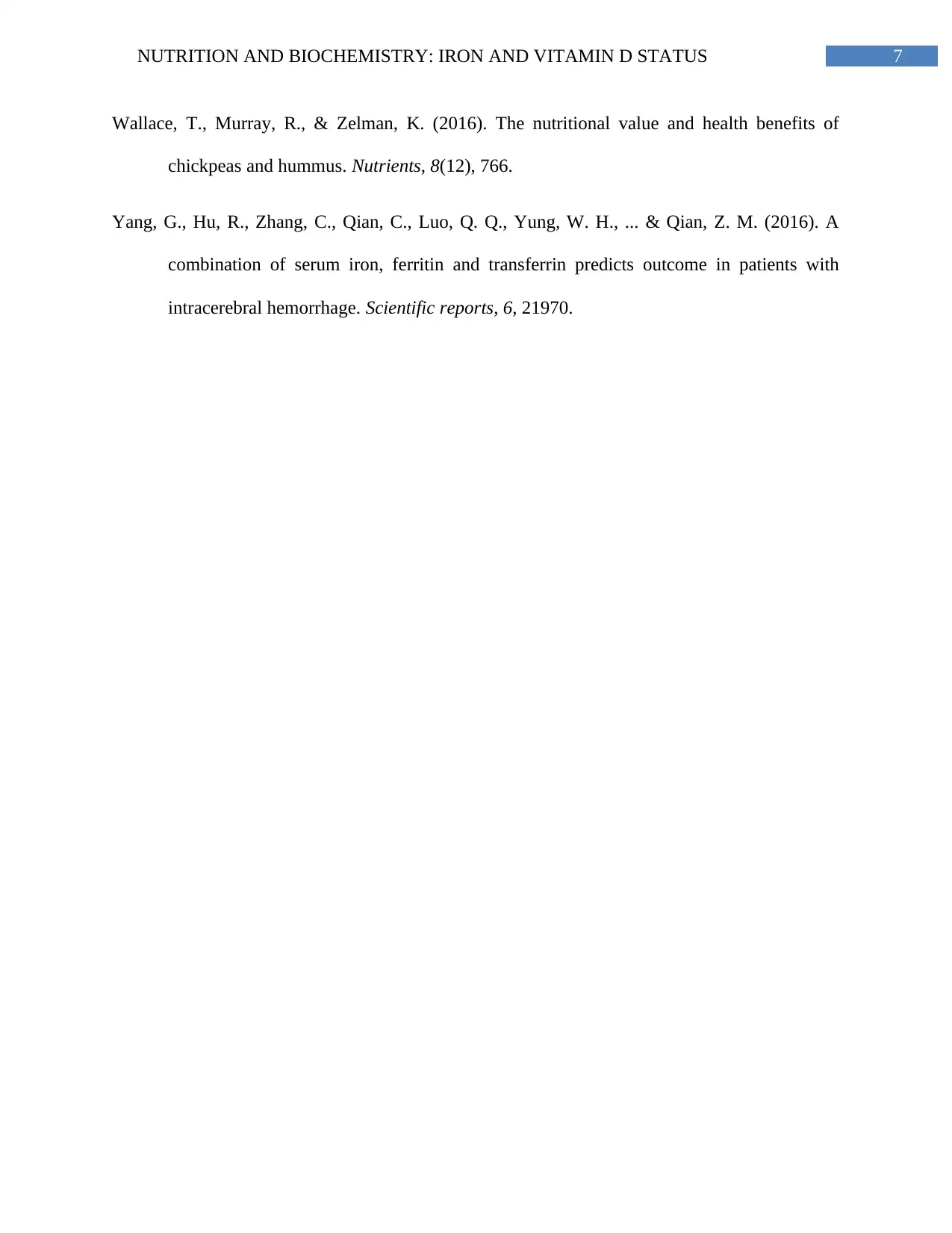
7NUTRITION AND BIOCHEMISTRY: IRON AND VITAMIN D STATUS
Wallace, T., Murray, R., & Zelman, K. (2016). The nutritional value and health benefits of
chickpeas and hummus. Nutrients, 8(12), 766.
Yang, G., Hu, R., Zhang, C., Qian, C., Luo, Q. Q., Yung, W. H., ... & Qian, Z. M. (2016). A
combination of serum iron, ferritin and transferrin predicts outcome in patients with
intracerebral hemorrhage. Scientific reports, 6, 21970.
Wallace, T., Murray, R., & Zelman, K. (2016). The nutritional value and health benefits of
chickpeas and hummus. Nutrients, 8(12), 766.
Yang, G., Hu, R., Zhang, C., Qian, C., Luo, Q. Q., Yung, W. H., ... & Qian, Z. M. (2016). A
combination of serum iron, ferritin and transferrin predicts outcome in patients with
intracerebral hemorrhage. Scientific reports, 6, 21970.
1 out of 8
Your All-in-One AI-Powered Toolkit for Academic Success.
+13062052269
info@desklib.com
Available 24*7 on WhatsApp / Email
![[object Object]](/_next/static/media/star-bottom.7253800d.svg)
Unlock your academic potential
Copyright © 2020–2025 A2Z Services. All Rights Reserved. Developed and managed by ZUCOL.
